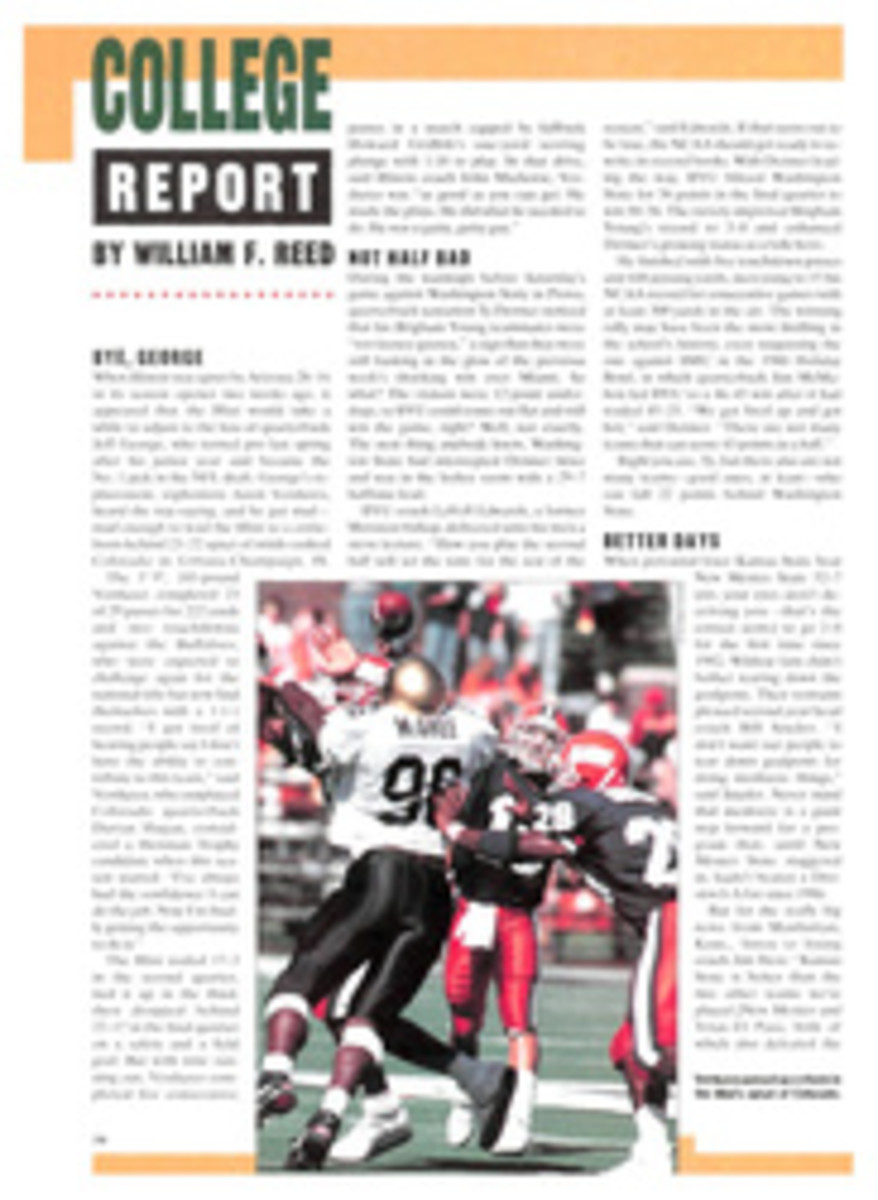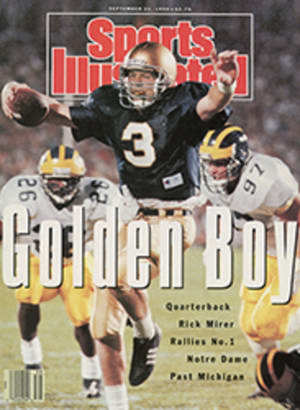
SCORECARD
HOOKED
A new study by the U.S. Department of Health and Human Services underscores how difficult it will be to persuade the nation's estimated 250,000 adolescent users of anabolic steroids to give up the drugs. Of 55 adolescent steroid users interviewed (nearly a third of whom have been taking the drugs for five years or longer), 93% said they believe they made "a good decision" by starting to use steroids, and 87% would make the same decision today "without hesitation." More than 80% of the users, who included males and females, said steroids had made them bigger and stronger, and that "the improvements I achieved by using steroids made me more popular."
A vast majority said they felt no peer pressure to stay away from steroids—indeed, 85% said friends influenced them to start taking the drugs—and nearly two thirds of those on sports teams disagreed with the statement "My coaches really believe that steroid use is a bad idea." More than half said their parents "probably know" they use steroids.
Perhaps most worrisome, 82% of the users disagree with medical experts who say steroid use poses long-term health risks, including liver and heart disease. Many users pointed out that the same experts used to say, inaccurately, that steroids don't work. And though many users admitted that steroids have had negative effects on them—bloated appearance, acne and shrunken testicles, for example—87% said they believe that "the bad effects of steroids go away as soon as you stop using."
The study concludes that these young steroid users, like users of many addictive drugs, show signs of dependence and strong denial. The users might be wise to talk to the 17 former adolescent steroid users—some now in their 20's—interviewed for the study. Nearly all said that steroids do cause the aforementioned long-term health problems. One of the former users said that he is sterile because of steroid use, and that as a result of injecting steroids with a shared needle, he now carries the AIDS virus.
PLAYING THE MARKET
There won't be a trading floor, and opening and closing prices won't be listed in The Wall Street Journal. But other than that, the soon-to-be-operating National Collectors Exchange (NACEX) for baseball cards will work much like the New York Stock Exchange.
"A collector wanting to sell a card will have it electronically entered into the exchange's computers," says NACEX marketing director Art Skula. "Because there are thousands of potential buyers in every city or town where there is a NACEX broker, the chances for making a quick sale at a fair price will be enhanced tremendously."
NACEX, a private company based in Maitland, Fla., has worked out an agreement with the Major League Baseball Players Alumni association, which will receive a portion of every $2 transaction fee and of every $30 NACEX membership fee. The association hopes that a number of former ballplayers will fill jobs as brokers on the exchange.
The exchange is intended to bring stability and integrity to the baseball card market, while turning a tidy profit for NACEX. "People who are interested in the baseball card market will now be able to buy, sell or trade cards every day, not just at card shows on weekends," says former Cleveland Indians infielder Lou Klimchock, the national sales director for NACEX. "They won't have to lug all of their cards all over the place."
By the way, according to NACEX, since 1980 baseball card collections have risen in value four times more than stocks on the New York exchange's corporate list.
OPENING THE DOOR
Faced with the possibility of picketing and sponsor boycotts at next year's Masters because of its exclusionary membership practices, the Augusta National Golf Club announced last week that it recently admitted its first black member, Ron Townsend, president of the Gannett Television Group. Townsend, a 15 handicapper who belongs to other private golf clubs in Florida and his home state of Maryland, credited John Curley, the chairman of the Gannett Co., with arranging a meeting between Townsend and Augusta National members in July, during the uproar over the holding of the PGA Championship at the Shoal Creek club in Birmingham. Townsend says he was formally invited to join shortly thereafter and "I didn't waste any time in accepting."
Under antidiscrimination guidelines adopted by the PGA Tour in the wake of the Shoal Creek controversy, all clubs hosting Tour events (the Masters is not a Tour event) must demonstrate by next year that their membership practices aren't discriminatory. Toward that end, the Champions Golf Club in Houston, site of next month's $2.5 million Nabisco Championship, the Tour's richest event, said last week that it is about to admit its first black member, Walter King, a real estate developer and husband of Marguerite Ross Barnett, the University of Houston's new president. One hopes that Townsend and King will be but the first of many, black members at their clubs.
Meanwhile, officials of the Western Open, the second-oldest U.S. tournament (only the U.S. Open is older), said they will no longer hold the event at the Butler National Golf Club in Oak Brook, Ill., because Butler doesn't want to admit women members. Next year's Western Open will be played on one of the nation's top public courses, the Dubsdread course at the Cog Hill Golf and Country Club in Lemont, Ill.
ON THE RUN
Among the many cleverly named teams in last week's Nike Capital Challenge (a three-mile road race in Washington, D.C., involving runners from Congress, the White House, the judiciary and the media) were the Al Gore Rhythms (captained by the Tennessee senator), Read My Splits (a White House squad), USDA Foot Stamps (from the Department of Agriculture) and No Ways No Means (from the House of Representatives). A squad from Runner's World magazine, Do the Write Thing, won the team title, but for legal beagles the highlight was seeing Supreme Court Justice Anthony Kennedy run with All Deliberate Speed, which finished second among judiciary teams.
NEW TEAM FOR AN OLD COACH
When John Pont's rèsumè arrived in the mail in early 1988, sister Francis Marie Thrailkill, president of the College of Mount St. Joseph, a small (enrollment 2,700) Catholic school in Cincinnati, was startled. She saw Pont's credentials—22 years as football coach at Miami of Ohio, Yale, Indiana, which he guided to the 1968 Rose Bowl, and Northwestern, where he also served four years as athletic director—and asked herself, Why on earth would this man want to come here?
The answer is that Pont, who had spent the previous three years as athletic director of Hamilton (Ohio) High, missed college coaching. When he read that Mount St. Joseph, a women's school until 1984, planned to start a football program to attract more male students and boost campus spirit, he couldn't wait to apply. "I talked to John and found that he is a real educator," says Sister Francis Marie. "I gave him the job without interviewing another soul."
Pont, 62, thereupon built—literally, in some respects—the Lion football program. He designed and stained lockers and helped lay carpeting for the school's first men's locker room. He got a local surgeon to donate training room equipment. Although he had little to offer high school prospects except playing time (Mount St. Joseph, an NAIA Division II school, awards no athletic scholarships), Pont sent out 1,000 recruiting letters and got 300 players to visit the school. Largely because of football, male freshman enrollment at Mount St. Joseph nearly tripled this fall, to 90. (Overall, the student body is still 78% female.)
The Lion program is wonderfully small time. Pont and his seven assistant coaches (six of them part-time) do the team laundry themselves after practice. The Lions have to play their home games at a nearby high school because Mount St. Joseph's largest athletic field is only 90 yards long. At least one of Pont's players, wide receiver John Piminedis of Thessaloníki, Greece, had never touched a football until this summer. "There's one kid, he weighs, like, 135 pounds, and he's really struggling with whether he should stay with the program," says Pont. "I hope he does, because I know that sometime in the next four years he'll catch a touchdown pass and that will be a moment he'll remember all his life."
Pont truly cares about his players. "The rule during staff meetings is that if a player comes in and wants to talk to Coach, the meeting breaks up," says assistant Bill Piper. The players repaid Pont two weeks ago in Terre Haute, Ind., by winning their debut game, 31-10, over Rose-Hulman. Last Friday, with 15 freshmen in the starting lineup, the Lions lost at home 32-14, to Hanover College.
To support the team, the Mount St. Joseph art department has come up with a more ferocious-looking lion logo to replace the sweet-faced lioness traditionally used for the school's women's teams. Even the nuns from the hilltop convent overlooking the school grounds show up for games and wave when they see Pont strolling the campus. "How's recruiting going?" one asked Pont the other day on her way to chapel. Yelled another from the distance, "We're praying for you, Coach!"
ILLUSTRATION
PATRICK MCDONNELL
PHOTO
TONY TOMSIC
Pont offers his young Lions wisdom and clean laundry.
THEY SAID IT
•Ron Meyer, Indianapolis Colt coach known for his malapropisms, shrugging off his bold decision to start rookie Jeff George at quarterback this season: "It isn't like I came down from Mount Sinai with the tabloids."
•Beano Cook, ESPN football commentator, making a comparison of two University of Virginia notables: "Virginia already has spent more on plugging [quarterback] Shawn Moore for the Heisman Trophy than Thomas Jefferson spent getting elected President."

